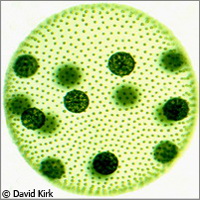Shedding light on the evolution of multicellular life
The evolution of multicellular life may not have required as much genetic modification as was previously thought, new research suggests. Writing in the journal Science, an international team of researchers explains how it compared the genomes of two closely related species of algae: the multicellular Volvox carteri and the single-celled Chlamydomonas reinhardtii. Multicellular life has arisen more than once, in animals, plants and fungi, as well as in red and brown seaweeds. However, in most cases this happened so long ago that teasing out the genetic changes behind the switch from a single-celled to a multicellular way of life is extremely tricky. The volvocine green algae represent an important exception, as V. carteri and C. reinhardtii diverged from a shared, single-celled ancestor less than 200 million years ago. V. carteri consists of two cell types; around 2,000 small cells are embedded in a spherical extracellular matrix, and each of these cells bears two flagella, which V. carteri uses to move around. Meanwhile, 16 large reproductive cells lie just below this layer. According to the researchers, the level of divergence between the two algal genomes is comparable to the divergence between the human and chicken genomes. 'We expected that there would be some major differences in genome size, number of genes, or gene families' sizes between Volvox and Chlamydomonas,' commented Professor James Umen of the Salk Institute in the US. 'Mostly that turned out not to be the case.' In fact, the two genomes proved to be remarkably similar. This suggests that Volvox did not need to invent new proteins to switch to a multicellular way of life, but instead drew on the genetic resources it already had. 'This was somewhat unexpected, since innovation at the domain level was previously thought to play a role in the evolution of multicellularity in the plant and animal lineages,' Professor Umen pointed out. 'If you think of proteins in terms of Lego bricks, Chlamydomonas already had a great Lego set. Volvox didn't have to buy a new one, and instead could experiment with what it had inherited from its ancestor.' Nevertheless, the analyses did uncover some differences between the two species' genomes. For example, Volvox has far more extracellular matrix genes. The Volvox extracellular matrix is related to the Chlamydomonas cell wall, and the difference in size and complexity between the two structures is reflected in the number and variety of Volvox genes for extracellular matrix proteins. In addition, Volvox has more proteins involved in cell division, and it appears to have adapted some of its existing genes to adopt new functions. For example, some subtypes of a gene family involved in the construction of the extracellular matrix have evolved into a hormonal trigger for sexual differentiation. 'Our comparisons of Volvox and Chlamydomonas indicated that... the developmental innovations in the Volvox lineage did not involve major changes in the ancestral protein repertoire,' the scientists write. 'This is consistent with previous observations indicating co-option of ancestral genes into new developmental processes.' Looking to the future, the team plans to investigate gene regulation in Volvox. The hope is that this will shed new light on the factors driving the evolution of multicellularity in these organisms.
Countries
Canada, Germany, Japan, United States



